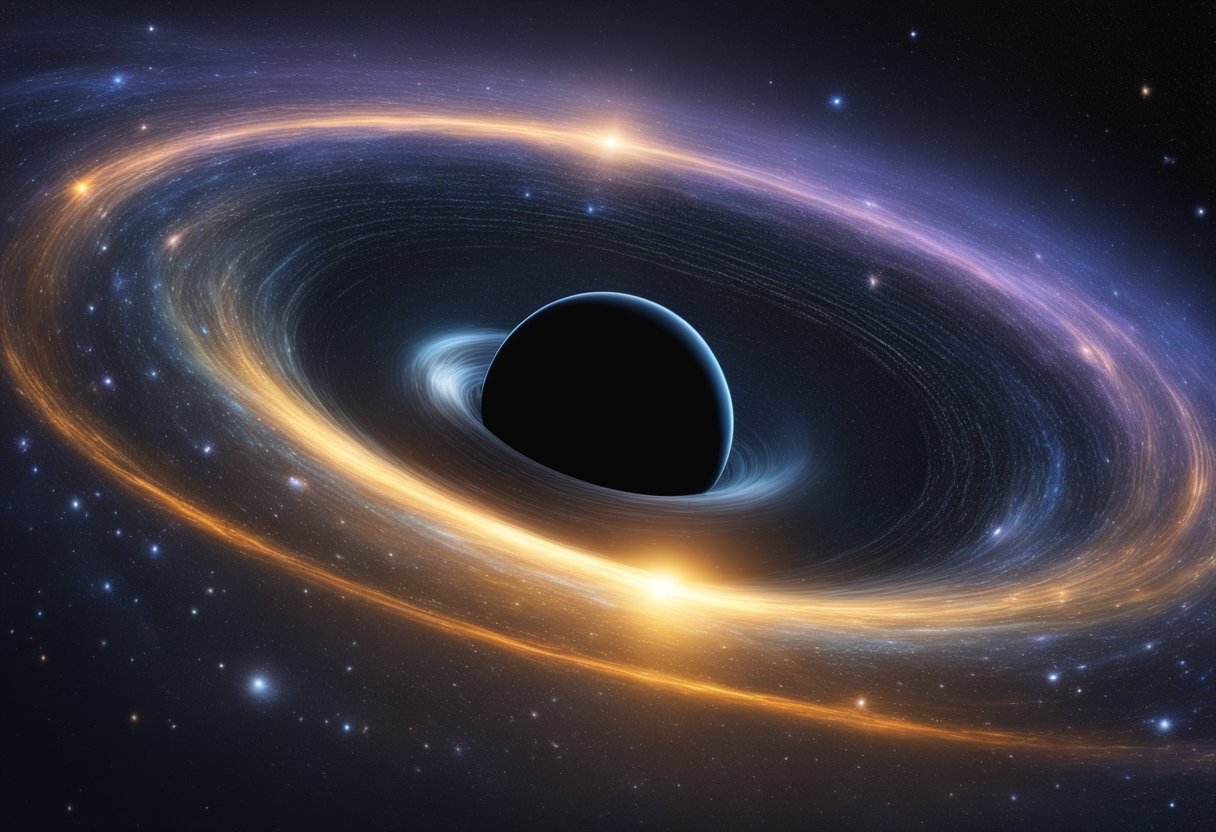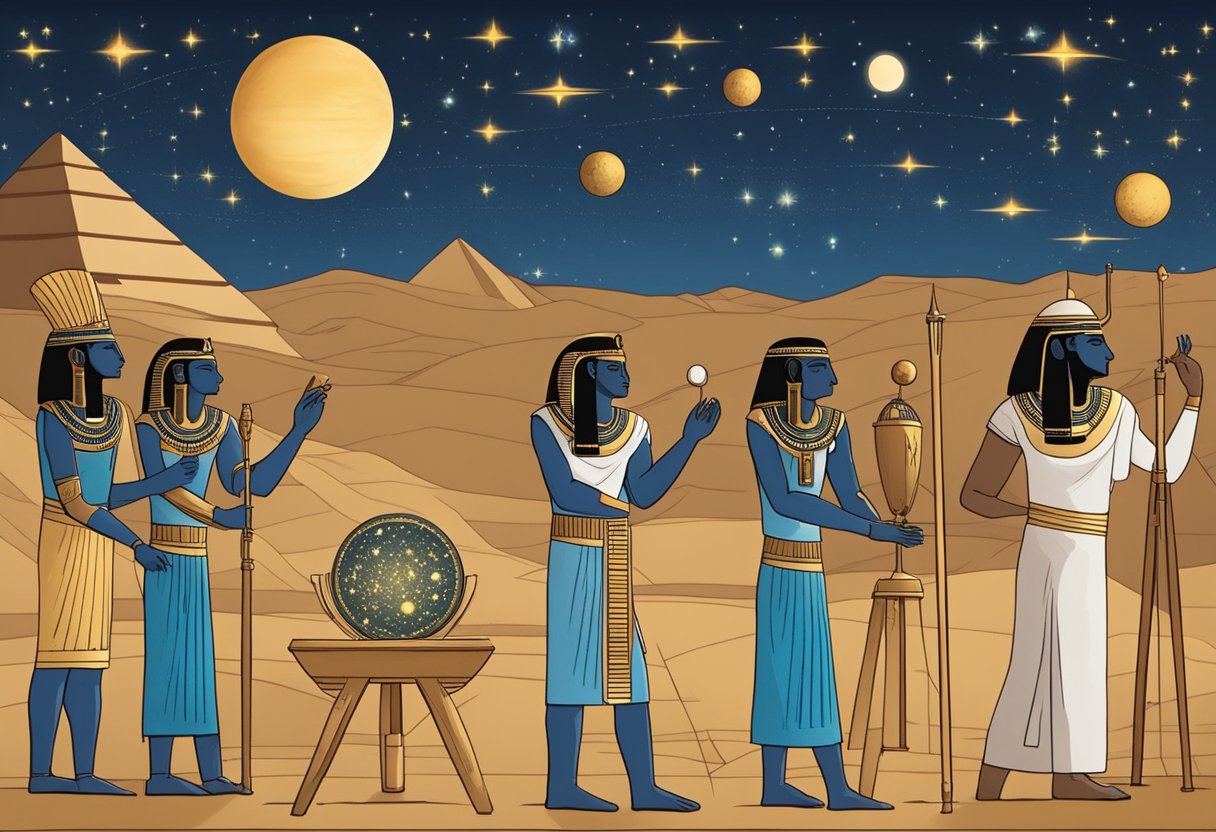The Debate Over the Shape of the Universe: From Antiquity to the Modern Era
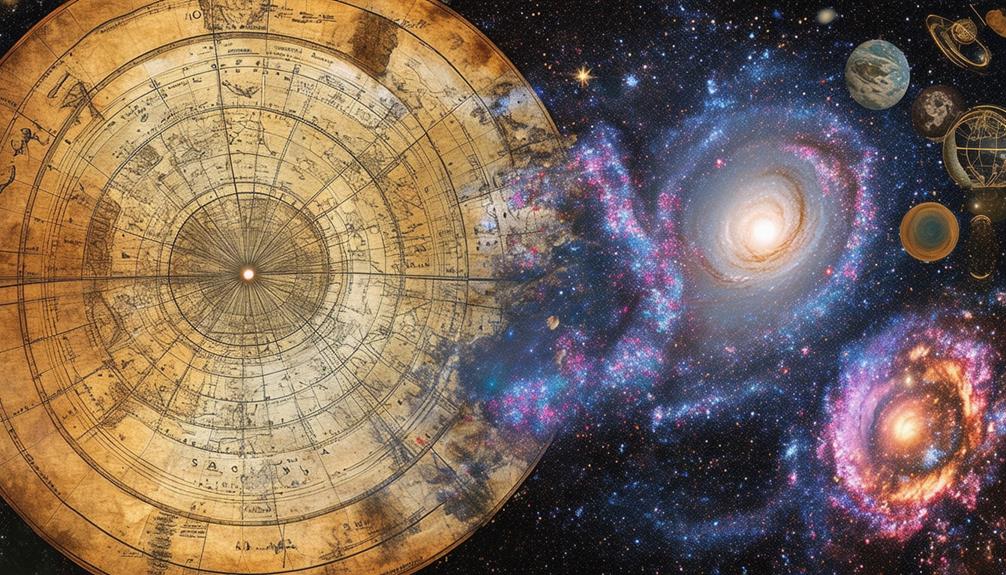
Imagine you're standing under a starry sky, pondering the universe's shape. Throughout history, this question has intrigued minds from Aristotle to modern cosmologists.
Ancient Greeks envisioned a geocentric, spherical cosmos, while medieval thinkers placed Earth at the center of a grand celestial sphere.
The revolutionary insights of Copernicus and Hubble dramatically shifted our understanding, sparking new debates. Today, advanced telescopes offer glimpses into the universe's vast and intricate structure, yet many questions remain unanswered.
What does current research suggest about the universe's geometry, and where will future inquiries lead? Let's explore how these ideas have evolved and what the future might hold.
Ancient Philosophers' Theories
Ancient Greek philosophers, such as Aristotle, significantly influenced early cosmological theories by advocating a geocentric universe composed of four fundamental elements: fire, air, water, and earth. They posited that Earth was the center of the cosmos, with all celestial bodies orbiting it. This geocentric model was deeply rooted in their observations and philosophical beliefs.
Aristotle introduced the concept of the quintessence, a fifth element he believed constituted the heavens. Unlike the four earthly elements, the quintessence was thought to be perfect and unchanging. Aristotle's ideas dominated for centuries, shaping the way people viewed the universe.
Aristarchus of Samos and Eratosthenes made significant contributions to our understanding of the cosmos through their pioneering measurements. Aristarchus estimated Earth's size using lunar eclipses, while Eratosthenes measured Earth's circumference based on the shadows cast during the summer solstice. Their methods demonstrated a sophisticated understanding of geometry and the scale of the universe.
Greek astronomers like Ptolemy further developed these models by incorporating epicycles and deferents to explain the complex motion of celestial bodies. These intricate models aimed to account for the observed paths of stars and planets, reinforcing the geocentric perspective of the cosmos.
Medieval Cosmological Models
Medieval cosmological models, rooted in Aristotle's geocentric teachings, depicted Earth as the universe's central hub. Ptolemy's geocentric system, in particular, employed complex mechanisms like epicycles and deferents to explain the motions of celestial bodies, aiming to align observational evidence with the geocentric view that celestial spheres revolved perfectly around a stationary Earth.
Islamic scholars such as Al-Biruni and Alhazen significantly refined these medieval models. Through meticulous astronomical observations, they improved the accuracy of celestial predictions, preserving and expanding upon ancient Greek knowledge with their innovative methods and insights.
During this period, Christian theology intertwined with Greek and Islamic cosmological ideas. Scholars and theologians negotiated a balance between religious beliefs and scientific observations, leading to diverse interpretations and vigorous debates about the universe's structure. These discussions profoundly influenced the worldview of the era, shaping humanity's perception of its place in the cosmos.
Renaissance Astronomy Advances
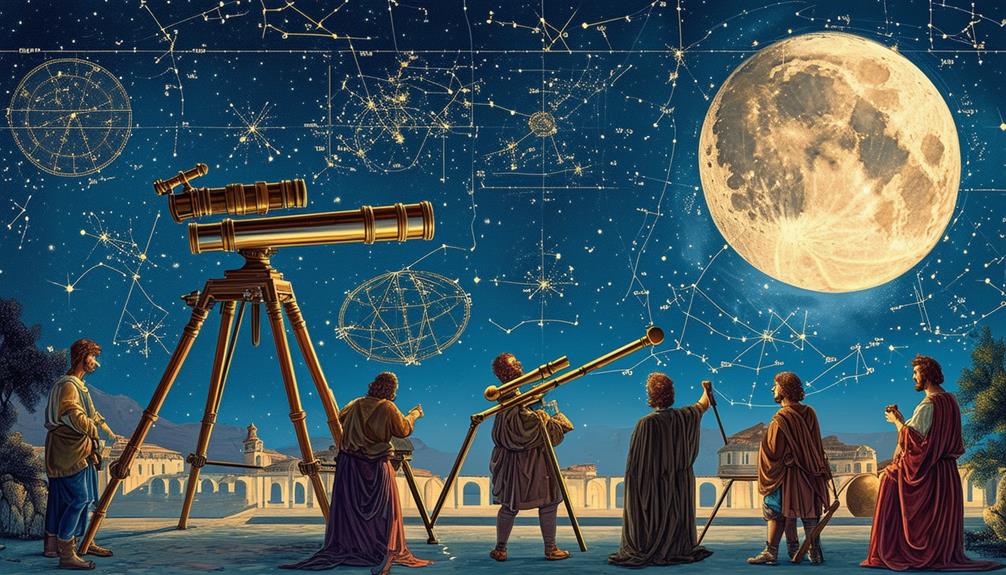
During the Renaissance, a pivotal transformation in astronomical understanding occurred. Copernicus proposed the heliocentric model, fundamentally challenging the long-held geocentric views.
Galileo's telescopic discoveries provided substantial evidence supporting this new perspective.
Concurrently, Kepler's laws of planetary motion offered the mathematical accuracy necessary to understand celestial mechanics.
Copernican Heliocentric Model
During the Renaissance, Nicolaus Copernicus revolutionized astronomy by proposing a heliocentric model, placing the Sun at the center of the solar system. This groundbreaking idea challenged the long-held geocentric view, which asserted that Earth was the universe's center.
Copernicus's heliocentric model suggested that Earth and the other planets orbited the Sun, fundamentally altering the understanding of the cosmos.
The heliocentric model didn't gain immediate acceptance but gradually led to a significant paradigm shift in astronomy and cosmology. Over time, it redefined humanity's place in the universe and set the stage for future scientific advancements.
Johannes Kepler's laws of planetary motion further bolstered the heliocentric model by revealing that planets move in elliptical orbits around the Sun, offering a more accurate description of their movements than the previously assumed circular orbits.
Copernicus laid the groundwork for a new epoch in scientific inquiry, encouraging others to question established beliefs and seek evidence-based insights about the nature of the universe.
While Copernicus's ideas were revolutionary, it was the subsequent findings and confirmations, such as those by Kepler, that solidified the heliocentric model's credibility and paved the way for modern astronomy.
Galileo's Telescopic Discoveries
Galileo's telescopic discoveries revolutionized the field of astronomy and ushered in a new era of scientific inquiry. Using his telescope, Galileo discovered that the Moon's surface wasn't smooth but featured mountains and craters, challenging the prevailing belief in the celestial perfection of heavenly bodies.
Turning his telescope to Jupiter, Galileo identified four large moons orbiting the planet, providing compelling evidence against the geocentric model that posited all celestial bodies revolved around Earth. His observations of Venus' phases further supported Copernicus' heliocentric model, which argued that planets, including Earth, orbited the Sun.
Galileo also observed sunspots, demonstrating that the Sun itself had imperfections, which further contradicted the idea of flawless celestial bodies. These discoveries did more than merely challenge existing beliefs; they fundamentally reshaped our understanding of the cosmos.
Today, advanced space telescopes continue Galileo's legacy, exploring the universe far beyond the capabilities of his early instruments.
While Galileo's telescope was rudimentary by modern standards, his pioneering efforts laid the groundwork for the sophisticated telescopes that now extend our knowledge of the universe's vastness.
Kepler's Planetary Laws
Kepler's groundbreaking planetary laws redefined our understanding of planetary motion within our solar system. By challenging the long-held belief in circular orbits, Kepler's laws provided a more accurate description of how planets move.
His first law states that planets move in ellipses with the Sun at one focus, a radical departure from the idea of perfect circular orbits.
Kepler's second law, known as the law of equal areas, explains that a planet sweeps out equal areas in equal times, meaning planets move faster when they're closer to the Sun and slower when they're farther away.
His third law, the law of harmonies, establishes a relationship between a planet's orbital period and its distance from the Sun, stating that the square of the orbital period is proportional to the cube of the semi-major axis of its orbit.
These revolutionary laws paved the way for advancements in Renaissance astronomy and laid the foundation for Newton's laws of motion and universal gravitation:
- Ellipse Orbits: Planets move in ellipses, not circles.
- Variable Speeds: Planets speed up when closer to the Sun.
- Orbital Periods: A planet's year is related to its distance from the Sun.
Newtonian Universe
Newton's universe, rooted in the concepts of absolute space and time, presents a deterministic and predictable cosmos governed by precise mathematical laws. In this framework, matter moves in response to absolute forces. Newton's laws of motion and universal gravitation provide a solid foundation for understanding how objects interact.
You can envision his universe as a vast, intricate clockwork mechanism where every piece operates in harmony, ensuring a perfectly balanced system of celestial bodies.
In Newton's view, space is infinite and unbounded, challenging earlier notions of a finite, enclosed cosmos. This infinite expanse contains matter that behaves predictably, strictly adhering to Newton's laws. The idea of an infinite, static, and unchanging universe marked a significant shift from previous models, which often depicted the cosmos as a finite entity.
You can visualize Newton's universe as a static tableau, where planets, stars, and other celestial bodies move in a perfectly choreographed dance, each obeying the immutable laws of physics. This concept of a clockwork universe underscores the predictability and determinism that define Newton's vision.
His contributions laid the groundwork for later advancements, setting the stage for future explorations into the nature of the cosmos.
General Relativity's Impact
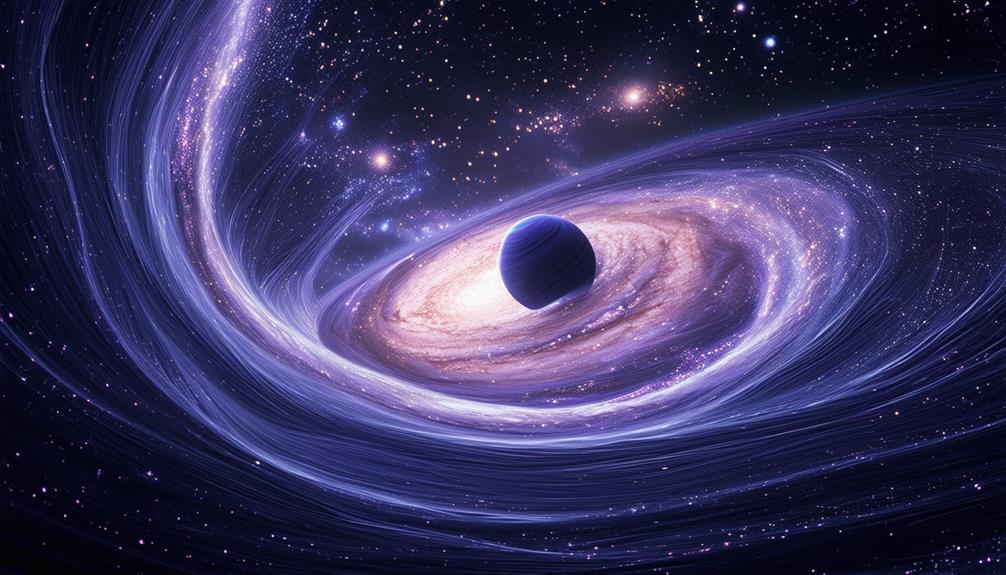
Albert Einstein's General Relativity, proposed in 1915, revolutionized our comprehension of gravity and spacetime. Unlike Newton's deterministic universe, General Relativity reveals that mass-energy warps the fabric of spacetime, fundamentally altering the motion of objects.
General Relativity's influence is extensive and multifaceted, predicting and explaining several crucial phenomena:
- Gravitational Lensing: The bending of light around massive objects, such as galaxies, due to spacetime curvature.
- Time Dilation: Slower passage of time in stronger gravitational fields, notably near massive objects.
- Bending of Light: Curvature of light rays when passing close to massive bodies, confirmed during solar eclipses.
- Gravitational Waves: Ripples in spacetime from violent astrophysical events like black hole mergers, first detected in 2015.
Einstein's equations provide the theoretical foundation for these phenomena, reshaping our understanding of the universe's structure.
The observation of gravitational waves, in particular, has validated a crucial aspect of General Relativity, cementing its importance in modern physics.
Through General Relativity, we gain a deeper appreciation for how mass and energy sculpt the very fabric of reality.
Big Bang Theory Emergence
The Big Bang Theory gained prominence after the discovery of cosmic microwave background radiation in 1965 provided compelling evidence for a universe that began from a single, dense point. Georges Lemaitre had already laid the groundwork for this theory with his proposal of a 'primeval atom' or a single point of origin. Observations by astronomers like Vesto Slipher and Edwin Hubble supported this idea by showing that galaxies are moving away from each other, indicating an expanding universe.
Friedmann's equations, developed in 1922, offered mathematical support for an expanding universe, reinforcing the Big Bang Theory. These equations described how the universe could evolve over time, aligning with the observed data. The cumulative evidence from these scientific advancements led to the growing acceptance of the Big Bang Theory.
Here's a concise summary of key points:
| Key Event/Person | Contribution to Big Bang Theory |
|---|---|
| Georges Lemaitre | Proposed the universe had a single point of origin |
| Vesto Slipher | Observed redshifts in galaxies, suggesting expansion |
| Edwin Hubble | Demonstrated the universe is expanding |
| Friedmann's equations | Provided mathematical support for expansion |
| 1965 Discovery | Cosmic microwave background radiation evidence |
These milestones collectively shaped the Big Bang Theory, solidifying its role as the leading explanation for the universe's origin.
Steady State Model Debate
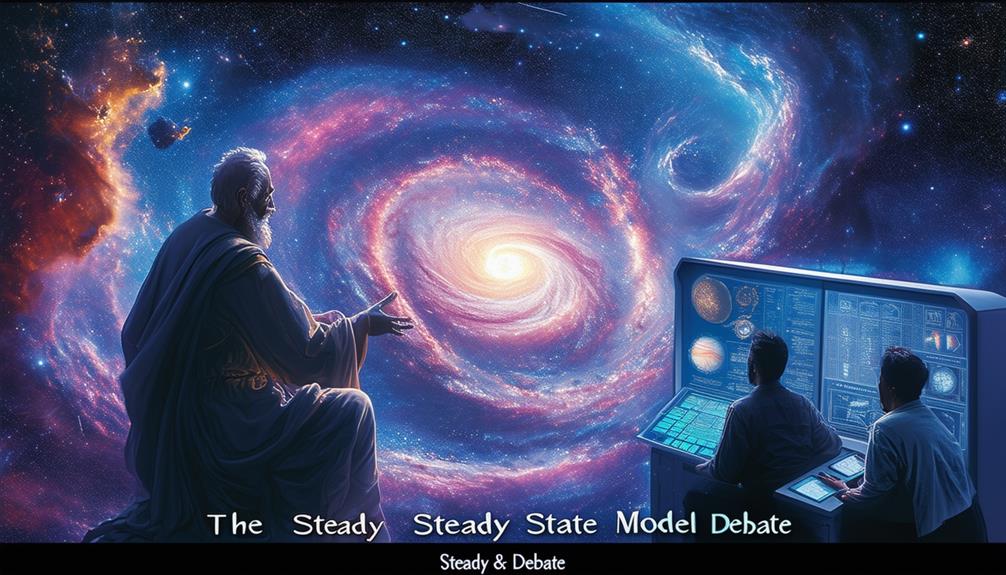
The Steady State Model presents an intriguing perspective with its notion of the continuous creation of matter, proposing an eternal and unchanging universe. This theory stands in direct contrast to the Big Bang model, which posits a singular origin for the universe.
As we examine these ideas, it's important to consider how the Steady State Model envisions a cosmos that appears the same throughout time, despite contrary evidence.
Continuous Creation Hypothesis
Imagine a universe where new matter constantly springs into existence, maintaining the cosmos in perpetual balance. This is the essence of the Continuous Creation Hypothesis, a fascinating idea proposed by Fred Hoyle and his colleagues.
Unlike the Big Bang Theory, the Steady State Model suggests that the universe has no beginning or end. Instead, it's always expanding, with new matter continuously created to fill the gaps.
The Steady State Model aimed to explain the universe's expansion without invoking a singular origin event. Proponents believed this eternal, constantly changing cosmos offered a more elegant solution to cosmological questions. This hypothesis sparked significant debate in the mid-20th century, challenging the prevailing Big Bang Theory.
To better appreciate this intriguing concept, consider these key points:
- Continuous Creation: Matter is constantly created, maintaining a constant density despite the universe's expansion.
- No Beginning or End: The universe is eternal, with no starting or endpoint.
- Dynamic Cosmos: The Steady State Model promotes the idea of a continuously changing cosmos.
- Mid-20th Century Debate: The hypothesis led to significant discussions, contrasting sharply with the finite universe proposed by the Big Bang Theory.
The Continuous Creation Hypothesis showcases a unique perspective on the universe's nature, continuing to inspire curiosity and debate.
Eternal Universe Theory
Debates regarding the Eternal Universe Theory, or Steady State Model, intensified as scientists like Fred Hoyle and Thomas Gold disputed the singular origin proposed by the Big Bang Theory. They proposed a universe with no initial or final point, where new matter is continuously generated to maintain the universe's density. This concept contrasted sharply with the Big Bang Theory, which posits that the universe originated from a singular event and has been expanding ever since.
The Eternal Universe Theory particularly appealed to those who found the idea of a definite starting point challenging to accept. Hoyle, Gold, and their contemporaries believed that the large-scale characteristics of the universe remained unchanged over time. Their hypothesis of continuous matter creation was essential in maintaining a stable condition, hence the term Steady State Model.
However, the Steady State Model faced significant challenges. Observational evidence, such as the detection of cosmic microwave background radiation, strongly supported the Big Bang Theory. Gradually, more scientists leaned towards the Big Bang Theory, but the debate surrounding the Eternal Universe Theory highlighted the dynamic and evolving nature of cosmological research.
Cosmic Microwave Background
The Cosmic Microwave Background (CMB) provides a snapshot of the universe's infancy, revealing crucial information about its early state and evolution. Discovered in 1965, the CMB is the residual radiation from the early universe, remarkably uniform in all directions. This uniformity supports the Big Bang Theory, which posits that the universe began from an extremely hot and dense state and has been expanding ever since.
The CMB acts as a cosmic relic, offering a direct view of the universe at around 380,000 years old. Tiny temperature variations in the CMB, at levels of one part in 100,000, confirm the universe's initial hot and dense condition. These minute fluctuations eventually led to the formation of galaxies and large-scale structures observed today.
Over the years, observations of the CMB have been refined by instruments like the Planck space telescope. These advancements help cosmologists understand the universe's composition, age, and rate of expansion.
Key points:
- Uniformity: The CMB is consistent in all directions.
- Big Bang Support: Provides strong evidence for the Big Bang Theory.
- Temperature Variations: Minor fluctuations confirm early conditions.
- Refined Observations: Enhanced by instruments like the Planck telescope.
Modern Cosmological Observations
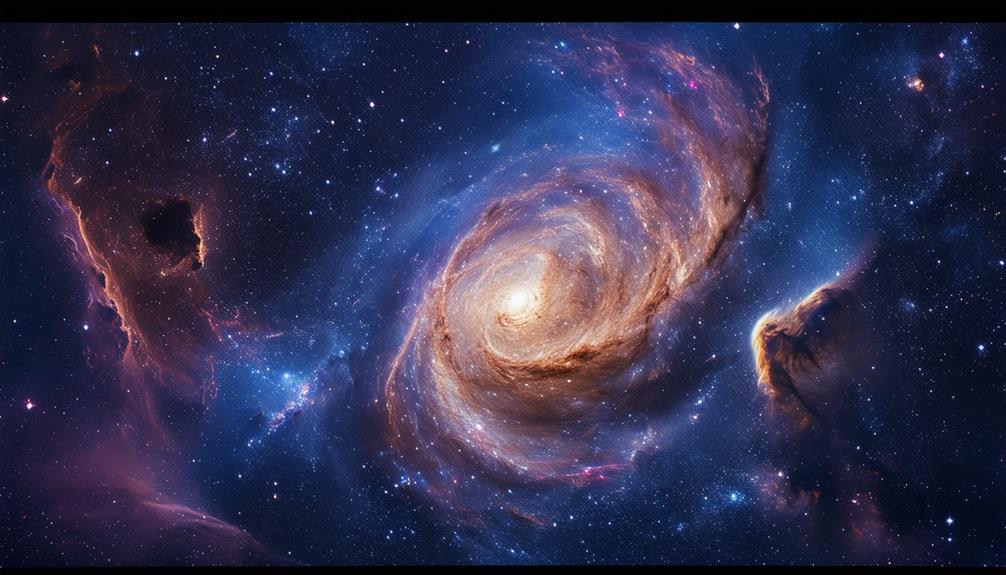
Recent cosmological observations, particularly from the Planck space telescope, are transforming our understanding of the universe's geometry.
These findings, along with anomalies in the Cosmic Microwave Background (CMB), suggest the possibility of a closed universe rather than a flat one.
Space Telescope Insights
Space telescopes such as COBE, Hubble, WMAP, and Planck have revolutionized our understanding of the universe's shape, structure, and dynamics. These advanced instruments have provided unprecedented insights into the universe's curvature, density, and overall configuration. By studying the Cosmic Microwave Background (CMB), these telescopes have supplied critical data that refine our cosmological models and theories.
Here's a look at four significant contributions from these space telescopes:
- COBE (Cosmic Background Explorer): COBE delivered the first detailed measurements of the CMB, confirming the Big Bang theory and enhancing our understanding of the universe's large-scale structure.
- Hubble Space Telescope: Hubble has mapped the universe in extraordinary detail, revealing the distribution and movement of galaxies, which aids in understanding cosmic expansion and the universe's shape.
- WMAP (Wilkinson Microwave Anisotropy Probe): WMAP provided a detailed map of the CMB, offering insights into the universe's age, composition, and structure, supporting the idea of a flat universe.
- Planck Space Telescope: Planck's precise measurements of the CMB have suggested that the universe might've a slight positive curvature, indicating it could be closed, challenging previous models of a flat universe.
These telescopes have dramatically transformed our understanding of the universe, continually reshaping our view of its vast and intricate nature.
Cosmic Microwave Background
Leveraging the capabilities of space telescopes, researchers can explore the Cosmic Microwave Background (CMB) to gain insights into the universe's early moments and subsequent evolution. The CMB, a faint radiation uniformly detected across the sky, is the afterglow of the Big Bang and provides compelling evidence for the Big Bang Theory, confirming that the universe was once in a hot, dense state.
Investigating anisotropies, or slight fluctuations, in the CMB reveals density variations in the early universe. These variations are crucial, as they eventually led to the formation of galaxies, stars, and other cosmic structures. Data from the Planck satellite has been particularly valuable, as it measures minute temperature fluctuations in the CMB, allowing scientists to determine the universe's composition, age, and geometry with remarkable precision.
Understanding the characteristics of the CMB isn't just about looking into the past; it also helps refine cosmological models and unravel the universe's mysteries. By studying the CMB, researchers gain a clearer picture of how the universe has evolved over billions of years, providing a solid foundation for ongoing and future cosmological research.
Future Research Directions
Future research will focus on resolving discrepancies in curvature measurements from CMB data to better understand the universe's shape. Over the years, scientists have debated whether the universe is flat, open, or closed. This ongoing investigation is essential for advancing our understanding of cosmology.
To achieve clearer insights, researchers will:
- Investigate Anomalies: By examining variations in CMB light, scientists aim to gain clues about the universe's shape and density.
- Refine the Lambda-CDM Model: The widely accepted Lambda-CDM theory, which predicts a flat universe, faces challenges. Researchers will reassess this model by integrating curvature parameters.
- Incorporate Curvature Parameters: Adding a curvature parameter has improved the fit with gravitational lensing measurements. This addition could significantly impact our understanding of the universe's shape.
- Evaluate the Look Elsewhere Effect: Some scientists are skeptical about adding a seventh parameter due to the look elsewhere effect. Future research must rigorously test whether this additional parameter genuinely enhances model predictions.
These research directions aim to resolve the inconsistencies currently challenging cosmological models, providing a clearer view of the universe's true shape. By addressing these key areas, scientists can advance our comprehension of the cosmos and its fundamental properties.
Conclusion
You've journeyed through centuries of cosmic debate, from ancient philosophers to contemporary scientists. Each era's discoveries have reshaped our understanding of the universe's structure.
Today, advanced observations, such as those from the Planck telescope, provide richer insights but leave many questions unanswered. The quest isn't over.
Future research promises to further unravel the universe's mysteries, continuing the legacy of curiosity and exploration that spans human history. Keep exploring; the universe has more to reveal.

